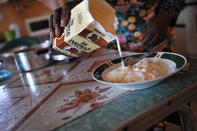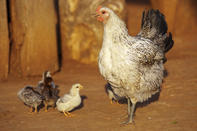Xhosa Cooking Customs
Meat recipes are conspicuous by their absence from many traditional recipes. AmaXhosa reared animals like cattle, goats, sheep and pigs both for meat for the family to mark special occasions and for status.

For example, it has always been custom to slaughter an ox for the burial of the head of the house, and for serious situations when the blessings of ancestors were requested. On other occasions besides a funeral, a goat was slaughtered ‘to clear the way’ (‘intshayelelo’) before the sacrificial ox was slaughtered.
All meat was cooked over an open fire or roasted – braaied, basically – and embellishments like spices had no place in Xhosa cooking in early times. The uprooting effect of migration into the cities brought the traditional Xhosa housewife into contact with the White ‘Madam’s’ ways of cooking, and interesting recipes were thus learnt. It is considered improper to include in this collection meat recipes used today in Xhosa homes, because that will be using other people’s innovations wrongly.
Meat for Special Occasions

An elderly Xhosa woman remembers as a child only getting meat – a chicken, or mutton maybe – when an animal was slaughtered, usually on a special occasion. A cow was for the more important rituals. You did not just slaughter an animal when you felt like meat.
And you did not miss red meat when you did not have it, she says. Chickens, on the other hand, might find themselves on the butcher’s block a bit more frequently. ‘Your rural household, you’ll rarely find one without some chickens outside. Free-range today, you think it’s a new thing?’ she chuckles. Killing a chicken was a good way to mark a slightly less special occasion. ‘Like passing Standard Three at the end of the year, you catch a chicken.
Even in Cape Town, my mother would buy a chicken from the store – a live one, we never saw chicken pieces – and when we passed a class, it would be cooked. But you’d be excited because a chicken had been slaughtered for you. And when it came to dishing out, we were given gravy and the legs. We enjoyed having a leg to ourselves.’ Then the mirth begins to stir in her voice, igniting her eyes, because there was a strict hierarchy behind who got the prime cuts of meat – the men, usually – and who got the lesser cuts – the women, then the children.
‘When we meet, my brothers and I, we talk about how much we were deceived by these parents,’ she twinkles. ‘They enjoyed the rest of the chicken, and we were excited just to have a leg, and yet the special occasion was ours!’ After the woman’s family settled on the Cape Flats, her mother’s cooking became more European in style because of what she was learning as a domestic worker in the German couple’s home.
Now the vegetables were served on the side, rather than mixed into something like the imifino where the leaves are all cooked up into a porridge with the maize. With the meat, starch and vegetables all served up in discrete portions, she and her siblings would try to wriggle out of eating their vegetables by pushing them to one side, like just about any child that tries to hide their peas under the napkin.
By Leonie Joubert